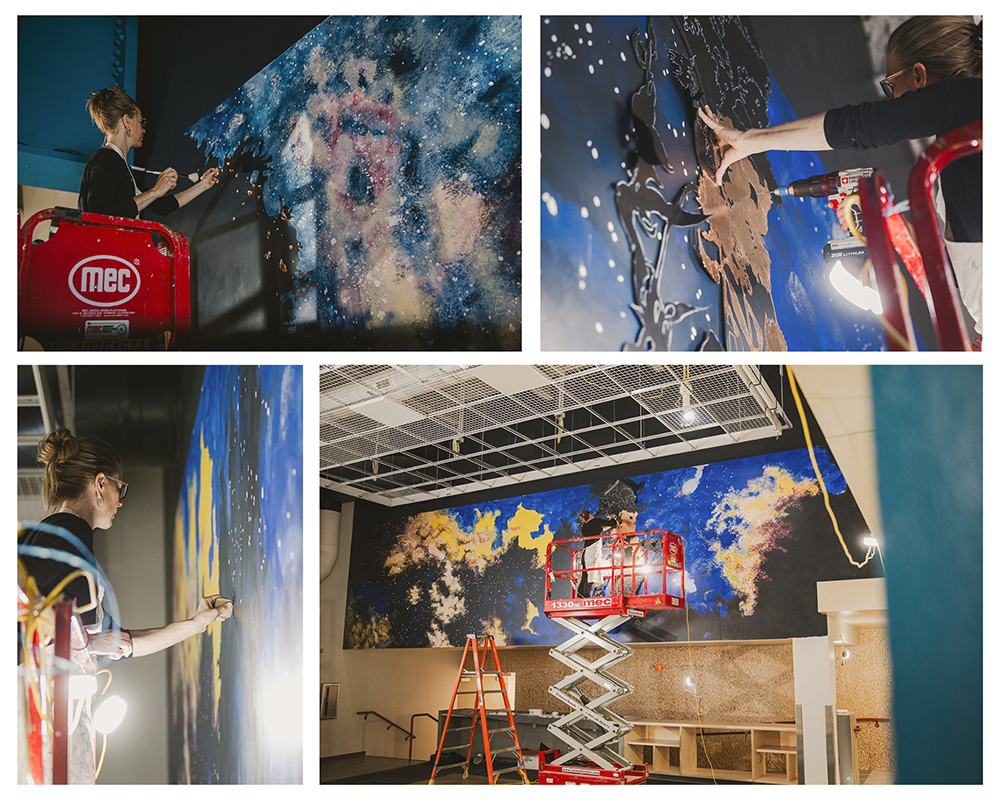Intersections of art and science: STEM TRAIL Center's new art
One of the first things visitors to the new STEM TRAIL Center in the lower level of Roskens Hall on UNO's Dodge campus notice is the bold artwork: a pair of murals that combine the night sky with 3D botanical designs covered in copper leaf, and along the hallway, a series of 15 panels that light up when the viewer walks past, revealing intricate patterns from the natural world.

Photo credit: Ben Semisch
This art, more of an experience than simply a collection of works, was created by Lee Emma Running, an Omaha-based artist who specializes in public installations that use cast iron, enamel, glass, and even bone and handmade paper. Running's art came to the STEM TRAIL Center through the Nebraska Arts Council, who issued a nationwide Request For Qualifications for the space.
Running submitted her initial proposal in 2023 and was awarded a small stipend to develop the idea further. She then pitched her idea to a panel, which included individuals from UNO and the architects, and was chosen from among three finalists for her work to adorn the STEM TRAIL Center's new location.
Running is no stranger to higher education spaces. Before pursuing her art full-time, she served as Professor of Art at Grinnell College from 2005 to 2021.
Running says she's interested in the specificity of place and how that specificity can manifest through artistic expression. Her work is driven by her connection to the natural world and the precise wonder a certain location can produce. She grew up in Colorado and says she struggled at first to orient herself in the "nature" of Nebraska.
"When I think about the natural world, I think about the Rocky Mountains, so it really took me a bit of time to figure out where the 'nature' was, because so much of the land here is used for agriculture."
But Running discovered an abundance of nature--and the inspiration for her work in Roskens Hall--at Merritt Reservoir near Valentine. There, she worked with the amateur astronomers who gather for the annual Nebraska Star Party each year to take advantage of the reservoir's International Dark Sky designation. This certification, which is issued by DarkSky International, means the area's lack of artificial light provides exceptional night sky viewing opportunities.
"There is as much light at Merritt as there was when electricity was invented," said Running.
At the Nebraska Star Party, she asked some of the astronomers to send her night sky images, which she later used as guides to create her murals. Much like an ancient navigator using the stars like a map, Running used a Doodle Grid to create glyphs that helped orient the star photographs to the wall and allowed her to place the stars as accurately as possible in relation to the edges of the walls in Roskens and to the faint silhouettes of trees in the murals. This techniques also allowed her to more easily fill in the background, which includes celestial nebulae that shift subtly over and behind the stars in shades of blue and black.
"I was really thinking about lenses, and how we see things," Running said. "The lenses in telescopes allow us to see things in darkness and objects that are so, so far away."
Another way of seeing Running engaged with: during the day at the Nebraska Star Party, she would collect botanical specimens to examine under a microscope. She traced these microscopic images, which became the patterns that were sandblasted into the 15 panes of glass in the hallway of the STEM TRAIL Center.
"So with these works, I'm really looking at two technologies, the technologies of the telescope and the microscope and how those two things can be used for us to understand different parts of the natural world."
Running is also interested in the intersections between the accessibility of technology and its relations to nature, and how our everyday interactions with technology can yield new encounters with art. The microscope Running used for the project was a basic model that simply plugs into the USB port of a computer. The electronics that illuminate the 15 panels when the user walks by are powered by Arduino microcontrollers along with custom circuitry. The motion sensor activates a strip of LED lights, illuminating the sandblasted designs. This open-source electronics platform is based on easy-to-use hardware and software that can often be found in STEM education. Running and her collaborator, Chris Russell, achieved this impressive effect with simple technical approaches and low-cost components.
Running said she hopes her artwork in the lower level of Roskens invites viewers to consider perception and how it can change, much the way her own perception shifted when she visited Merritt Reservoir.
"Everyone (at Merritt, during the Nebraska Star Party) decides together to just have no light, and we just watch the sunset. And then your eyes adjust, and then you have this access to the sky right above you. If you don't turn on a headlight, if you don't turn on your phone, everyone just lives in this space of darkness for a week, and really, it changes so many things about perception."